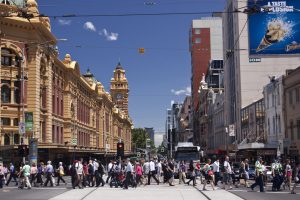Melbourne population predicted to overtake Sydney by 2030s
Melbourne’s population is set to overtake Sydney by the 2030s to become Australia’s largest city, The Australian reports.
Sydney’s current population of 5 million is approximately 350,000 ahead of Melbourne, but this lead is narrowing at a rate of 20,000 a year. If present rates continue, Melbourne would replace Sydney as Australia’s largest city as early as 2031.
Melbourne’s advantage over Sydney
According to Australian Demographer and Curtin University Professor, Bernard Salt, Melbourne is attracting more growth than Sydney because it offers “what Sydney cannot or will not offer: access to affordable housing on the urban fringe.”
“Figures released by the Australian Bureau of Statistics in March showed something remarkable,” he said. “In the year to June 2016 Melbourne added 108,000 residents. Sydney added 83,000. In 180 years of Melbourne’s history, never has the city added such a number.”
“For many Australians, the prospect of being able to own their own home, on a decent block of land on the urban fringe of Melbourne for between $450,000 – $500,000 is a highly appealing one,” said Ironfish National Housing Manager, Josh Ure. “Especially considering that the same type of package in North West Sydney, an even greater distance from the CBD would cost at least $800,000 – $900,000.”
Long-term city planning
Mr Salt attributes much of Melbourne’s population growth to the Kennett government years, which resulted in “Melbourne at 2030,” a plan for five million residents at 2030. The plan, which was announced in 2002, opened up the city’s west to new development less than 40km from the CBD.
Development areas in the west include the urban growth boundary between Werribee and Deer Park and further west to Melton, less than 40km from the CBD. New estates on the city’s eastern side are around Cranbourne and Officer, approximately 50km from the CBD.
Last financial year, about a third of Melbourne’s growth was delivered into the two, new urban-edge city-western areas of Melton-Wyndham and Casey-Cardinia. By the early 2050s Melbourne is predicted to house eight million residents, with Melton-Wyndham accounting for 660,000 residents and Casey-Cardinia contributing 500,000 residents over the 35 years from 2016.
“Growth at this scale delivers career surety to property industry players based in these regions. Growth at this scale requires new motorways and railways as well as more housing, shopping centres, schools, hospitals and workplaces such as offices and industrial buildings,” Mr Salt said.
The Australian dream
While the east is important, it is the west that is transforming the city, Mr Salt claims. The west will support double today’s resident workforce, with 330,000 net extra workers by 2050.
“The big-picture rethink of Melbourne that took place in the 1990s (and that Sydney never responded to) has in a single generation flipped the city’s growth focus from the east to include the west.
“Melbourne delivers the Australian dream of an affordable house on a separate block of land,” Mr Salt said.
Melbourne at a population of eight million is expected to span 100km between Melton and Pakenham with small-scale CBDs dotted along urban corridors or pressed up against natural barriers as Footscray is to the Maribyrnong River.
New business hub
While Sydney might have more corporate head offices than Melbourne, Mr Salt suggests that ultimately workers will value housing affordability.
“The housing and jobseeker market most readily gravitates to cities that deliver housing affordability combined with access to a capital city job market. And that is precisely what Melbourne is doing better than Sydney in the 21st century,” he said.

Alongside the population growth projection, house and land availability will also be affected.
“Over the next 20 – 30 years, available land around Sydney and Melbourne to build house and land developments will be significantly reduced. House and land within 50km of any CBD will be naturally under-supplied,” concluded Ironfish National Housing Manager, Josh Ure.
To find out more about property investment in Melbourne, contact Ironfish Melbourne or your local Ironfish strategist.